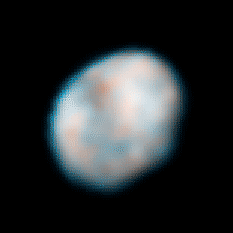Emily Lakdawalla • Feb 07, 2011
How much is Vesta's geology controlled by its one huge impact feature?
Here's a neat paper just published in Geophysical Research Letters: "Mega-ejecta on asteroid Vesta." In it, Martin Jutzi and Erik Asphaug consider Vesta's shape -- which appears to be dominated by a very large impact crater centered at its south pole -- and ask how much of the great big asteroid Vesta's global appearance is likely to be dominated by the effects of that one large impact. They studied the question using 3D computer simulations, which, to me, means one thing: cool animations.
As a reminder, here's what Vesta looks like to Hubble.

And here is what researchers think Vesta's shape looks like.

Vesta is an oblate body about 560 kilometers across through its middle but only 468 kilometers across, north to south; and the peculiar shape of its south pole suggests that the reason it's so noticeably non-round is that its south pole is an impact crater about 460 kilometers in diameter, which is to say, nearly as wide as the asteroid itself.
This big impact crater has excited geologists since it was first observed. Why? Because Vesta is pretty big, big enough to have differentiated as it formed -- separated into internal layers based on the density of its materials. As such, its formation and structure have similarities to how Earth formed. An impact crater this large and this deep could possibly have exposed the internal layering of a terrestrial planetary body to view in a way that we just can't see on Earth, the Moon, or Mercury. Possibly. But did it?
That's where the simulations come in. Jutzi and Asphaug tried out lots of starting conditions, from simple cases in which the impactor (likely a rocky body about 50 kilometers across, impacting at 5 kilometers per second) came down vertically onto a non-spinning Vesta, to complicated cases in which the impact was non-vertical onto a rotating Vesta. That last case is what's shown in the video below.
A model impact onto Vesta In a paper published in 2011 in Geophysical Research Letters, Martin Jutzi and Eric Asphaug modeled the effects of a 50-kilometer body striking a spherical, rotating asteroid the size of Vesta at an oblique angle. This animation shows the splash of the impact and the motion of the ejecta that spread out from it. Because of Vesta's rotation the ejecta is asymmetric in its distribution, piling up in a steep wall on one side of the asteroid and spreading out in a gradually shallowing deposit on the opposite side.Video: Martin Jutzi
COOOL. I love how the whole body participates in the splash, with the surface at "ground zero" rebounding from the impact to create a central peak. As liquid as this looks, everything that falls outside the crater would have remained solid throughout the impact process. And as Vesta rotates underneath the infalling ejecta, it spreads out across the hemisphere to the west of the impact site, creating an overturned flap of ejecta deposits that is similar to what you'd see in, say, a lunar crater. But the opposite thing is happening on the other side of the asteroid: its rotation acts to cancel out the outward motion of the impact ejecta, resulting in it all piling up fairly close to the crater rim, creating a "doubly overturned flap" and "other complex stratigraphic structures." You can see the asymmetric piling-up of ejecta deposits in this movie, which shows how the topography of Vesta would be different following the impact.
Ejecta distribution after a modeled impact on Vesta In a paper published in 2011 in Geophysical Research Letters, Martin Jutzi and Eric Asphaug modeled the effects of a 50-kilometer body striking a spherical, rotating asteroid the size of Vesta at an oblique angle. This animation shows the distribution of impact ejecta following the imapct. Orange shows the pre-impact elevations; reds are higher elevation than before; yellows through purples represent lower elevation than before the impact. There is a clear low center to the impact site but because of Vesta's rotation the ejecta is asymmetric in its distribution, piling up in a steep wall on one side of the asteroid and spreading out in a gradually shallowing deposit on the opposite side.Video: Martin Jutzi
It's a neat paper. Rather than drawing any specific conclusions about what exactly happened on Vesta, it explains what Dawn might observe, and how those observations could lead geologists to tell the story of what exactly happened to Vesta. (Dawn, if you've been paying attention to this blog, is NASA's ion-powered asteroid explorer, which will be arriving at Vesta this summer and spending a year there before departing for the biggest asteroid, Ceres.
Jutzi and Asphaug suggest that "Our results indicate that Vesta will reveal clear signatures for the impact parameter relative to the original spin axis, contained in the geologic features of mega-ejecta deposition. This will allow revised models that are tuned to reconstruct the interior of Vesta (from which the mega-ejecta derived), and also the trajectories, velocities, and source depths of Vesta's family of asteroids and meteorites." However, they warn, "we note one stunning and unexpected aspect of these impact simulations, namely the degree to which a mega‐impact on a rapidly rotating planet leaves behind mega‐ejecta forms which confuse the stratigraphy and can resemble massive endogenic constructs such as folds or thrusts.
The Time is Now.
As a Planetary Defender, you’re part of our mission to decrease the risk of Earth being hit by an asteroid or comet.
Donate Today

 Explore Worlds
Explore Worlds Find Life
Find Life Defend Earth
Defend Earth

